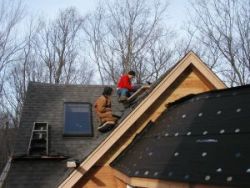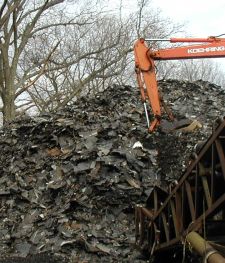Asphalt Roofing Shingle Recycling
 |
Facts and FiguresAn estimated 7 to 10 million tons of shingle tear-off waste and installation scrap is generated from roof installations every year. It is estimated that the construction of a new home requires between 3,000 to 4,000 ft2 of shingles, the installation of which equates to about 300-400 ft 2 of shingle scrap. Converting to a more user-friendly unit - asphalt shingles generally weigh between 175 - 233 lbs per "square", which is roofing jargon for 100 ft2 of new shingles. In 2007, there were 7746 new housing units constructed in Connecticut, thus it can be estimated that the housing market generated between 2,333,800 to 3,098,400 ft2 (or 2,133 - 3,610 tons) of asphalt shingle scrap. |
Asphalt shingles are the most common type of roofing material used in new home construction and re-roofing in the United States. According to the National Association of Home Builders (NAHB), an estimated 7 to 10 million tons of shingle tear-off waste and installation scrap is generated from roof installations every year.
Asphalt roofing shingles (ARS) have a great recycling potential in Connecticut:
- We generate an estimated 2800 tons of asphalt shingle scrap annually;
- ARS is easy to separate from other construction and demolition materials for recycling;
- CT currently has four permitted facilities to process ARS; and
- Use of recycled shingles in pavement can yield cost savings and provide points toward LEED (an internationally recognized green building certification system).
Asphalt Shingle Recycling Process
To prepare shingles for use in new products, the shingles must be ground to a specified size, and contaminants removed.
Grinding
Grinding may be easier in the winter when the asphalt is more brittle. If the shingles begin to stick together in hot weather, or from the heat of the equipment, spraying with water or blending with sand or gravel may help.
Sizing
Depending on the equipment used, primary grinding may yield 2" or 3"-minus size pieces. Secondary grinding may be required to make smaller pieces if needed; for example, aggregate base may require 3/4"-minus, and asphalt pavement may require 1/2"-minus or 1/4"-minus.
Grading
Depending on the use, the shingles may have to be sieved after grinding, to conform to grading requirements.
Contaminants
For virtually all uses, contaminants must be removed. Possible contaminants may include:
-
Metals, such as nails, which can be removed by a rotating magnet.
-
Wood, which sometimes accompanies shingles when the plywood is also replaced in a re-roof job. Wood can be removed by hand, or floated off in a water flotation unit.
Source: CalRecycle
Products Made From Recycled Asphalt Shingles
The following are potential end uses for recycled  asphalt roofing shingles:
asphalt roofing shingles:
- Hot-mix Asphalt (HMA) additive
- Cold patch for pothole repair
- Temporary roads, driveways and parking lots
- New shingles additive
- Aggregate road base
- Dust and erosion control at construction sites and rural roads, and
- Fuel
Pavements constructed with Hot-mix asphalt (HMA) modified with waste shingles are performing well in the state of Georgia. They have found that using shingles at a rate of 5% of mix weight has resulted in significant savings in cost of new asphalt binder as well as savings in disposal cost.
In Minnesota, field projects using shingles in HMA have found excellent performance and cost savings by reducing asphalt binder required in HMA. Shingle modified mixes were found to be as resistant to moisture as unmodified mixes, reported to have a slight increase in hardness of binder of the mix and resulting from the binder in the shingles, and there were no adverse of effects on low temperature properties of the HMA.
The Re-Roofing Waste Stream
The installation of new asphalt shingle roofs and reroofing generate the same types of waste materials; however re-roofing generates larger quantities.
| Material | % By Weight |
| Tear-off waste shingles |
85-90 |
| Metal flashing/detailing | 5-10 |
| Wood sheathing | <5 |
| "Tar" paper |
<5
|
| Paper packaging |
<1
|
|
Nails |
<1
|
Source: From Roofs to Roads (NAHB)
Asphalt Shingle Components
Asphalt shingles are made from these basic materials:
| Materials | % By Weight |
|
Felt Backing (fiberglass or cellulose) |
2%-15% |
|
Asphalt Cement (on fiberglass matt base) |
19%-22% |
|
Asphalt Cement (on felt matt base) |
30%-36% |
|
Mineral granules (aggregate)
|
20%-38% |
|
Mineral filler/stabilizer |
18%-40% |
Source: From Roofs to Roads (NAHB)
Asbestos
Numerous industries utilized asbestos in construction products such as asphalt and vinyl floor tiles, asphalt-containing roofing materials, and cement board. Asbestos was historically used in asphalt roofing shingles to act as a reinforcement (i.e. mat) for the shingle and also acted as a fireproofing/insulating material. Asbestos was banned from many products and uses in the 1970’s, but some roofing products may have contained asbestos until the early 1980’s.
According to CalRecycle, the incidence of asbestos-containing shingles in roof tear-offs today (old shingles) is extremely low. The total asbestos content of asphalt shingles manufactured in 1963 is only 0.02 percent; in 1977, it dropped to 0.00016 percent. Due to the practice of covering a worn out roof with new shingles, there may continue to be a very small amount of asbestos in the shingle waste stream until about 2016.
Asbestos Regulations
The agencies regulating asbestos are the U.S. EPA and the Connecticut Department of Public Health (DPH). However, any person, firm or corporation whether public or private, proposing to dispose of a "special waste" or asbestos must apply for a Special Waste Disposal Authorization from the Connecticut Department of Energy and Environmental Protection.
In Connecticut, all permittees (those who have received a General Permit for Storage and Processing of Asphalt Roofing Shingle Waste (ARSW) and/or for the Storage and Distribution of Ground Asphalt Aggregate (GAA) are required to conduct asbestos testing of ARSW unless they are 1) pre-consumer (new) shingles that have been certified by the manufacturer as not containing asbestos; 2) ARSW which has been tested by a certified laboratory prior to acceptance and accompanied with documented test results; and 3) post-consumer ARSW that has been generated from a residential source, documented by the contractor or generator, to have been constructed after 1981.
To learn more about the CT Department of Public Health’s Asbestos Program, visit their website, or call 860-424-3366.
Asphalt Shingle Recyclers in Connecticut
Asphalt Roof Recycling Center140 Watson Blvd.
Stratford, CT 06615
203-385-1000
Accepts asphalt roofing shingles only. Usually provides container for shingles.
Incorporated Industries, LLC
180 West Newberry Road
Bloomfield, CT 06002
860-242-0150
www.incorpind.com
Accepts roofing shingles in addition to clean wood, asphalt, concrete, and sand.
Babylon Recycling Center, LLC
1221 Harvey Lane
Suffield, CT 06078
860-746-3200
Accepts roofing shingles in addition to scrap metal, clean wood, separated wallboard scrap form new construction, asphalt, brick, concrete, pallets, gravel, stone and old corrugated cardboard.
Additional Resources
Articles and Publications
Recycling Tear-Off Asphalt Shingles: Best Practices Guide (CMRA) 2007
Recycling tear-off shingles: Paving Innovations (ForConstructionPros.com)
Environmental Issues of Recycling Tear-Off Roofing Shingles (Construction Materials Recycling Association [CMRA], et.al), 2009 WEBINAR – 5 different presentations
Environmental Issues Associated with Asphalt Shingle Recycling (CMRA) 2007 Report
From Roofs to Roads...Recycling Asphalt Roofing Shingles into Paving Materials, (NAHB Research Center), 1998
Roofs to Roads Innovative Recycling Grant (FL DEP) 2001
Recycled Asphalt Shingles in Road Applications: An Overview of the State of Practice (VT ANR) 1999
Literature on Asphalt Shingle Recycling (CMRA)
Overcoming the Barriers to Asphalt Shingle Recycling: Final Report for the RMRC Project 22 (Dan Krivit and Associates) 2005
Asphalt Roofing Shingles in Aggregate Base (CalRecycle)
Asphalt Roofing Shingles in Asphalt Pavement (CalRecycle)
Asphalt Roofing Shingles in Cold Patch (CalRecycle)
Evaluation of Use of Manufactured Waste Asphalt Shingles in Hot Mix Asphalt (Chelsea Center for Recycling and Economic Development, 2000)
From Roof to Road (Produced By: Michael Dobsevage, Video, 2.25 minutes, July 2001)
Recycling Roofs into Roads (Fine Homebuilding article, 2007)
Asphalt Shingle Waste Management in Northeast, Fact Sheet (NERC)
Asphalt Shingle Recycling in Massachusetts (Green Goat) 2005
Asphalt Shingles in HMA MoDOT Specification, Presentation (MO DOT)
Shingles in Paving Demonstration Project (King County, WA)
Georgia’s Experience with Recycled Roofing Shingles in Asphaltic Concrete (Transportation Research Board)
Minnesota’s Experience with Scrap Shingles in Bituminous Pavements (MN DOT) 1996
Organizations, Associations and Business
Connecticut Advanced Pavement Laboratory (UCONN)
Asphalt Shingle Recycling (CMRA)
Construction Materials Recycling Association (CMRA)
Asphalt Roofing Manufacturers Association (ARMA)
National Association of Home Builders Research Center (NAHB)
National Asphalt Pavement Association (NAPA)
Reduce/Reuse/Recycle | C&D Management
Disclaimer: The Connecticut Department of Energy and Environmental Protection (CT DEEP) maintains the content on this web site to enhance public access to information and facilitate understanding of waste reduction, reuse and recycling. The DEEP is not recommending these resources over any others and recognizes these represent only a partial listing of resources on this subject.
Content Last Updated May 19, 2020

